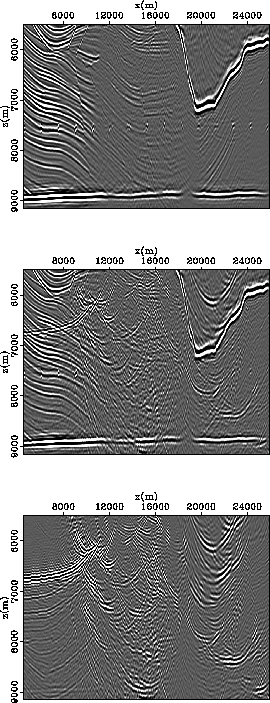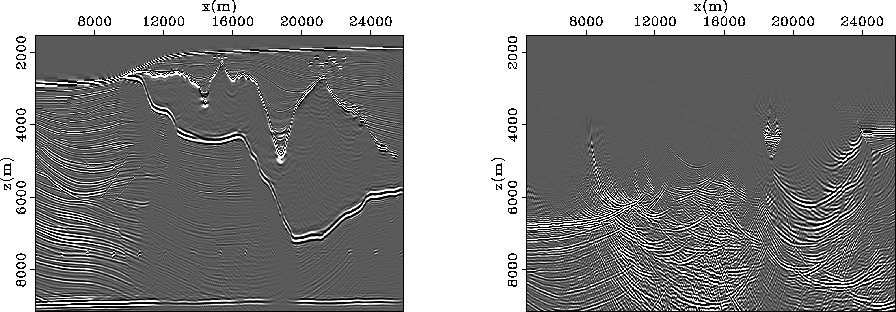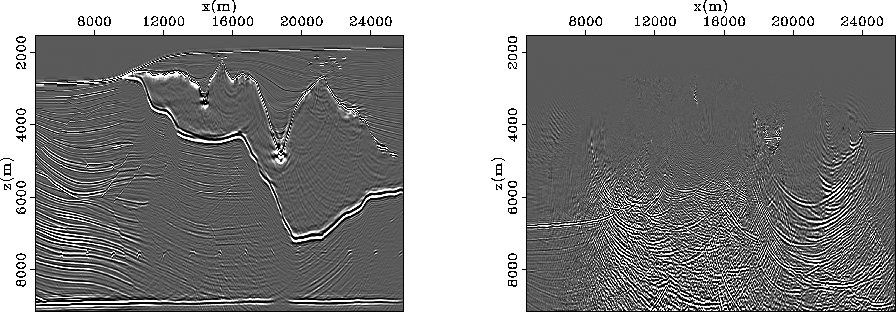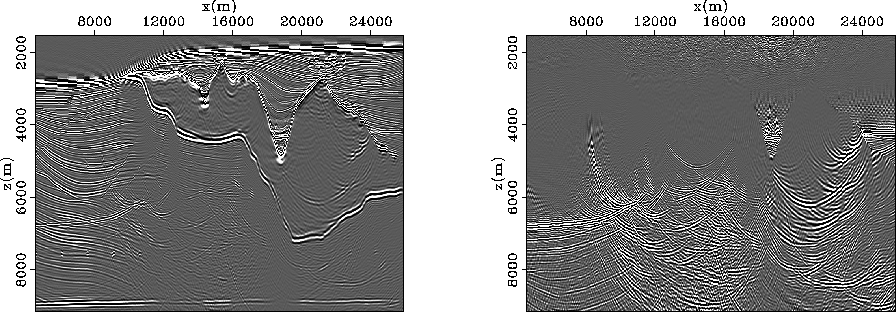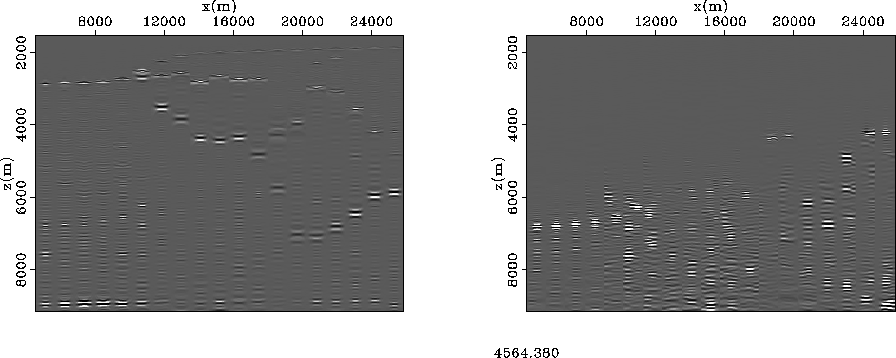




Next: Discussion and conclusions
Up: Artman and Matson: Multiple
Previous: Analytic example
The Sigsbee2B dataset was designed to model strong surface-related
multiples from an offshore acquisition. Two datasets were generated
with a 2D finite difference algorithm: One with the perfectly
reflecting free surface, and one
without![[*]](http://sepwww.stanford.edu/latex2html/foot_motif.gif) .
Therefore, the direct subtraction of the two data volumes yields a
perfect multiple model (modulo source and receiver ghost effects),
without the need for SRMP. Though the data
were modeled with an off-end acquisition strategy, split-spread
gathers were computed via reciprocity for all of the examples below.
.
Therefore, the direct subtraction of the two data volumes yields a
perfect multiple model (modulo source and receiver ghost effects),
without the need for SRMP. Though the data
were modeled with an off-end acquisition strategy, split-spread
gathers were computed via reciprocity for all of the examples below.
Figure 2 shows three versions of the bottom third of the
image produced with the Sigsbee2b data sets. The top image used the
data modeled without the reflecting free surface and contains only
primaries. The middle image migrated the data with the free-surface
and contains multiples as well. The bottom panel is the
image produced by migrating the difference between the two data
volumes (only multiples). The complex multiples in this deep section
quickly overwhelm the primary events and could easily be mistaken for
primaries in some instances. All panels, and the rest of the images
herein, were produced with four reference velocities in a PSPI
shot-profile migration code.
GEO-2006-0199-fig2
Figure 2 Images of the bottom third
of Sigsbee2b modeled data. Top panel is migration of primaries
only. Middle panel is migration of multiples and primaries. Bottom
panel is migration of multiples only.

Figure 3a shows the zero subsurface-offset image from
the data modeled without the free surface (multiple free). Panel b
was produced with the same data and the IS-SRMP imaging condition,
equation 8. By autoconvolving the upcoming wavefield U
at every depth level in the image space, the right panel shows only
multiples in the image domain using data containing only primaries. Note
that there is no energy in Panel b above the first water-bottom
multiple.
GEO-2006-0199-fig3
Figure 3 Zero subsurface-offset
images of Sigsbee 2b data without the free surface. Panel a used
conventional shot-profile imaging condition (equation 3).
Panel b used the multiple prediction imaging condition for IS-SRMP.
(equation 9).

Figure 4 is directly analogous to the images in
Figure 3, though employed the deconvolution imaging
conditions from equations 16 & 17
respectively. Notice the increased bandwidth of the events in Panel b
compared to the previous result and the increased quality of the
steeply dipping salt bottom in Panel a. Also, in the shallow
depths before the first water-bottom multiple and within the salt
body, the multiple prediction shows increased noise/chatter. This can be
muted before (adaptive) subtraction and should pose little problem.
GEO-2006-0199-fig4
Figure 4 Deconvolutional imaging
conditions used in contrast to Figure 3. Panel a
used shot-profile imaging condition with deconvolution
(equation 16). Panel b used the multiple prediction
imaging condition with deconvolution (equation 17).

Figures 5 & 6 are images produced with
conventional and deconvolutional imaging conditions, respectively,
using the data containing primaries and multiples. The multiples
below the salt body, which may be difficult to label as such without
prior knowledge, are well predicted.
GEO-2006-0199-fig5
Figure 5 Zero subsurface-offset
images of Sigsbee 2b data with the free surface. Panel a used
conventional shot-profile imaging condition (equation 3).
Panel b used the multiple prediction imaging condition
(equation 9).
 GEO-2006-0199-fig6
GEO-2006-0199-fig6
Figure 6 Deconvolutional imaging
conditions used in contrast to Figure 5 (free surface
included). Panel a used shot-profile imaging condition with
deconvolution, (equation 16). Panel b used the multiple
prediction imaging condition with deconvolution
(equation 17).

Guitton (2005) shows convincingly that pattern-based and adaptive
subtraction of multiple models work much better when higher
dimensinalities can be exploited by the subtraction algorithm. The
various imaging conditions presented above can all calculate
subsurface offset dimensions to facilitate better
subtraction. Figure 7 shows the extension of the
imaging conditions above to non-zero reflection
angle Sun et al. (2004). The data were migrated using the
imaging conditions above, and then transformed to the angle domain
after Sava and Fomel (2003). The data input to migration
contained both primaries and multiples, and the imaging conditions
used were not the deconvolutional variants.
GEO-2006-0199-fig7
Figure 7 Angle-domain common-image
gathers selected regularly across the image. Panel a used the
conventional imaging condition (equation 3), Panel b
the multiple prediction imaging condition (equation 9).
The volumes were then transformed to incidence/reflection angle.






Next: Discussion and conclusions
Up: Artman and Matson: Multiple
Previous: Analytic example
Stanford Exploration Project
1/16/2007
![[*]](http://sepwww.stanford.edu/latex2html/foot_motif.gif) .
Therefore, the direct subtraction of the two data volumes yields a
perfect multiple model (modulo source and receiver ghost effects),
without the need for SRMP. Though the data
were modeled with an off-end acquisition strategy, split-spread
gathers were computed via reciprocity for all of the examples below.
.
Therefore, the direct subtraction of the two data volumes yields a
perfect multiple model (modulo source and receiver ghost effects),
without the need for SRMP. Though the data
were modeled with an off-end acquisition strategy, split-spread
gathers were computed via reciprocity for all of the examples below.
